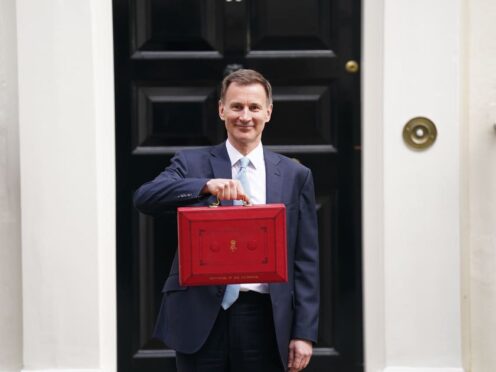Jeremy Hunt said tax cuts would offer “much needed help in challenging times” and stimulate economic growth as he set out Budget plans for pre-election giveaways.
The Chancellor, delivering a statement aimed at reviving both an ailing economy and reversing the Conservatives’ opinion poll deficit, said he was offering “permanent tax cuts” in a “Budget for long-term growth”.
Mr Hunt made a 2p cut in national insurance for workers and the self-employed the centrepiece of a tax-cutting Budget with an eye on this year’s general election.
He said the cut, which will come in from April, will result in the lowest effective personal tax rate since 1975 and could result in getting the equivalent of 200,000 more people in work.
He told MPs: “Because we are delivering the Prime Minister’s economic priorities, we can now help families not just with temporary cost-of- living support but with permanent cuts in taxation.
“We do this to give much needed help in challenging times. But also because Conservatives know lower tax means higher growth.
“And higher growth means more opportunity, more prosperity and more funding for our precious public services.”
Mr Hunt said inflation was set to fall to below the Bank of England’s 2% target “in a few months’ time”, easing the cost-of-living squeeze.
But he also set out a series of measures aimed at helping hard-pressed households, including:
– Changing the way child benefit is treated, with the individual earnings threshold at which it is taxed increasing from £50,000 to £60,000 from April.
– Freezing fuel duty and extending the “temporary” 5p cut for a further 12 months.

– A freeze in alcohol duty to February 1 2025.
– Extending the Household Support Fund with an extra £500 million.
Mr Hunt said gross domestic product (GDP) – a measure of the size of the economy – was also set to grow faster than previously forecast by the budget watchdog.
The Office for Budget Responsibility forecast growth of 0.8% in 2024, up from the 0.7% forecast in November, and 1.9% next year – up from 1.4% on the autumn forecast.
Growth was expected to be 2.2% in 2026, again higher than previously expected, 1.8% in 2027 – a 0.2 percentage point decrease – while the forecast for 2029 remained unchanged on 1.7%.
“Because we have turned the corner on inflation, we will soon turn the corner on growth,” Mr Hunt said.
The Chancellor said he would maintain his plan to increase public spending by 1% a year over the course of the next parliament, saying it would not be “wise to reduce that funding given the pressures that public services face”.
But he pledged to increase public sector productivity, including a package of NHS reforms which would “slash the 13 million hours lost by doctors and nurses every year” as a result of obsolete IT systems with a £3.4 billion investment.
He also promised an additional £2.5 billion for the NHS to “meet pressures in the coming year”.

Other changes to emergency services could include using drones as “first responders” to incidents “where appropriate”, as part of a £230 million plan to roll out new technology to speed up police response times, which could also allow victims to report crimes by video call.
The Chancellor confirmed he would scrap the current non-dom tax regime for wealthy foreigners with overseas earnings, replacing it with a “modern, simpler and fairer residency-based system”.
He said abolishing the non-dom status would raise £2.7 billion a year – which Labour, which had championed the policy, had pledged to put into NHS funding but which Mr Hunt put towards tax cuts.
For businesses, Mr Hunt increased the threshold at which small firms have to register for VAT from £85,000 to £90,000.
He also announced measures aimed at supporting investment in tech firms by unlocking pension fund investment.
And he confirmed a new British ISA will allow an extra £5,000 of tax-free investment in UK assets.
The Chancellor also offered more than £1 billion in extra tax breaks for the creative industries over the next five years.
Mr Hunt updated MPs on investments by firms including AstraZeneca, which has plans to pump £650 million into facilities in Cambridge and Liverpool.
